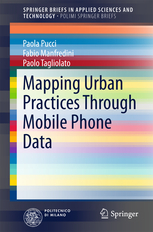Mapping Urban Practices through Mobile Phone Data

As part of the series PoliMI SpringerBriefs, published by Springer and Politecnico di Milano, this is a short and technology-focused work. It shows how the data from mobile phone networks and other technological sources might be used to assess urban mobility.
Chapter 1 outlines theoretical developments in understanding how people move, as studied from the 1920s and applied to cities from the 1980s.
Chapter 2 reviews the literature specifically on use of mobile phone network data. Among their advantages, mobile phones are ubiquitous, can continually capture data, and are able to provide very precise information. Practical uses are briefly mentioned. These could include planning of bicycle-sharing schemes according to which areas of a city have the highest intensity of mobile phone use, or urban zoning based on tracking of a population’s daily activities.
The book then moves from the general to the particular. Chapter 3 describes the case of Lombardy in Italy, where new maps were created based on mobile phone data. This work mapped the density of mobile phone traffic at particular times of day and during special events to understand shifts in use of urban space and infrastructure. It was even possible to determine the tourism patterns of different nationalities, for instance that Americans largely stuck to the city centre while Germans preferred the lake area.
Chapter 4 explores the implications for use of traditional data sources. A significant difference is that mobile phone data are gathered selectively by telecommunications companies. And given the relative novelty of this form of data, there are challenges in establishing how to interpret mobile data and what the appropriate scale of analysis would be. The chapter argues for more work to understand the role newer data sources can play alongside, and in integration with, more traditional ones.
Finally, Chapter 5 provides more examples of potential policy applications. These are largely in theory rather than in practice, showing again that this is still an emerging field of study.
Overall, the book focuses on methodological and technical considerations (sometimes very mathematical ones) more than social aspects, such as the ramifications for privacy, surveillance, participation, ownership of data, and technological exclusion. This shows the need for further research that builds on the work of Politecnico di Milano.
Further reading:
Bengtsson, Linus, Xin Lu, Anna Thorson, Richard Garfield and Johan von Schreeb (2011), “Improved Response to Disasters and Outbreaks by Tracking Population Movements with Mobile Phone Network Data: A Post-Earthquake Geospatial Study in Haiti”, PLOS Medicine, available at http://journals.plos.org/plosmedicine/article?id=10.1371/journal.pmed.1001083#pmed-1001083-g005.
Livengood, Avery and Keya Kunte (2012), “Enabling participatory planning with GIS: a case study of settlement mapping in Cuttack, India”, Environment and Urbanization Vol 24, No 1, pages 77–97, available at http://eau.sagepub.com/content/24/1/77.abstract.
Book note prepared by Christine Ro
Search the Book notes database
Our Book notes database contains details and summaries of all the publications included in Book notes since 1993 - with details on how to obtain/download.
Use the search form above, or visit the Book notes landing page for more options and latest content.
For a searchable database for papers in Environment and Urbanization, go to http://eau.sagepub.com/

